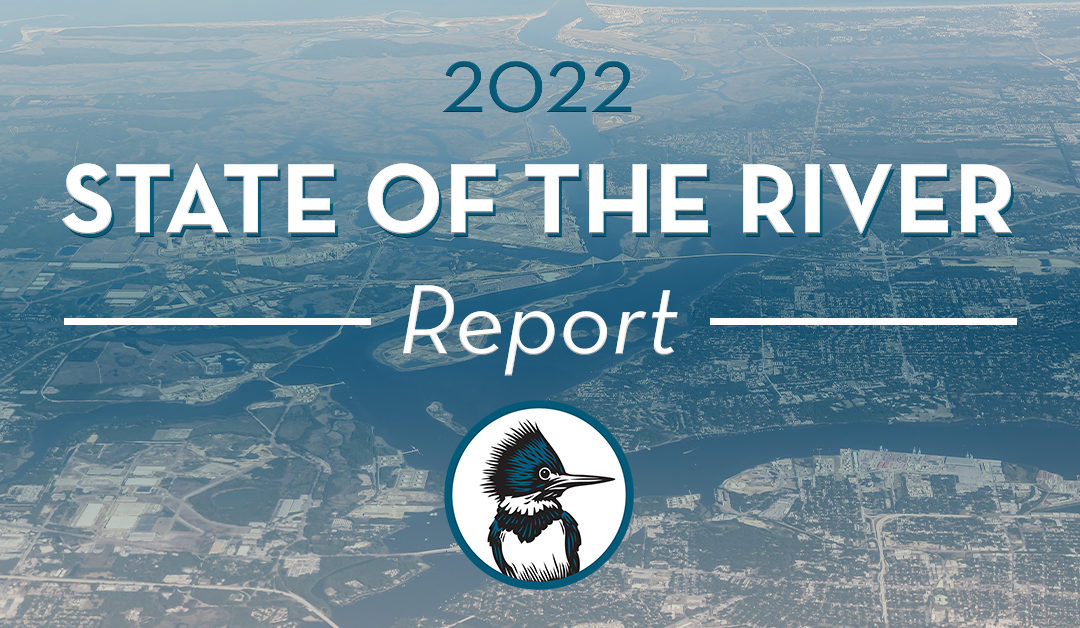The 15th annual State of the River Report for the Lower St. Johns River Basin provides significant reason for concern, while also providing a few glimpses of hope that some health indicators may be improving.
Funded by the Jacksonville Environmental Protection Board, The State of the River Report is produced annually by scientists and researchers from Jacksonville University, the University of North Florida, Westchester University, and Florida Southern College. The report evaluates the health of the Lower Basin by assessing the current status and trends of various health indicators related to Aquatic Life, Contaminants, Fisheries, and Water Quality.
First for the good news:
- Total nitrogen (TN) conditions in the mainstem of the Lower St. Johns remain “satisfactory”, with the caveat there were fewer measurements this year. Two major lawsuits involving our organization resulted in more stringent pollution standards that have led to significant reductions in nitrogen in the River over the last 15 years.
- The status of most of the fish species assessed remains satisfactory, while conditions are actually improving for striped mullet, the largest fin fishery in the region.
- Waterborne metal contaminants in the mainstem of the freshwater section of the Lower Basin remain satisfactory and unchanged since last year.
- The status remains satisfactory for manatees, bald eagles, and wood storks, with conditions actually improving for the latter two species.
Unfortunately, all is not well with our river. Here are some of the lowlights of the report:
- Measurements from 2017-2021 indicate a worsening trend for total phosphorous in the mainstem of the St. Johns, while the status for the tributaries remains “unsatisfactory” and unchanged from 2020. We believe the increase in phosphorous is in part due to the land application of sewage sludge upstream and indicative of the need for tougher standards.
- We continue to see a decline in wetlands and submerged aquatic vegetation (SAV’s) due to over-development, increases in salinity, and pollution. Unfortunately, the trend is to mitigate for wetland loss with the purchase of credits in mitigation banks, as opposed to creating or restoring wetlands.
- Salinity levels continue to be unsatisfactory and increasing (“conditions worsening”) due to sea level rise and dredging activities.
- Toxic algal blooms continue to be a problem in the freshwater St. Johns’ mainstem, as well as fecal coliform and dissolved oxygen in the tributaries, remain “unsatisfactory.”
- Sediment contaminants, such as PCBs, pesticides, metals and mercury, remain at unsatisfactory levels.
- While waterborne metals in the fresh section remain satisfactory, most waterborne contaminants continue to be a problem, forincluding pesticides, metals in the tributaries, silver in freshwater section, and copper,
cadmium, lead, nickel, silver in the estuarine section of the river. This year’s report also includes a highlight section on climate change impacts and a Storymap that demonstrates the risks some communities are facing due to socioeconomic inequities, flooding, and sea level rise.
Recommendations from St. Johns Riverkeeper:
- The Florida Legislature and Governor should finally allocate funding to breach the Rodman Dam and restore the natural flow of the Ocklawaha River. This would help to offset increased salinity and improve water quality in the river, by increasing the flow of freshwater into the St. Johns by at least 150 million gallons of water a day and restoring over 7,500 acres of forested wetlands.
- Significant funding is needed to remove failing septic tanks that continue to pollute our tributaries with harmful bacteria and nutrients and create a human health hazard.
- Additional protections must be enacted to prevent the further loss of wetlands and Submerged Aquatic Vegetation (SAV’s). Natural infrastructure provides critical habitat for fish and wildlife, filters pollution, prevents flooding, sequesters carbon, and provides a buffer from storm surge. Our wetlands, submerged grasses, mangroves, and natural lands are critical to creating more resilient communities.
- Excess phosphorous is still a problem for the St. Johns. The land disposal of sewage sludge in the Upper Basin and Middle Basin is likely a major source and must be more tightly regulated. Sewage sludge also contains numerous toxic chemicals and heavy metals that can pollute our river.
- The state of Florida, local governments, and utilities must aggressively reduce greenhouse gas emissions to address climate change. A warming planet is intensifying storms and increasing water temperatures and water levels. More frequent flooding and an increase in stormwater runoff means more pollution and sewage overflows washing into our river. Warmer waters leads to more algae blooms and fish kills, while rising waters cause more septic tanks to fail and salt water to contaminate our aquifer.
